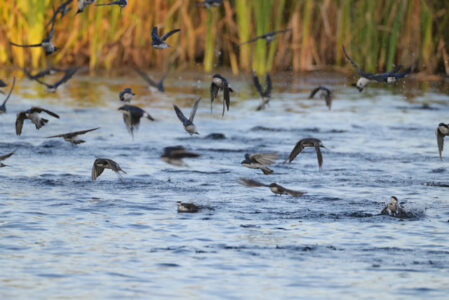How does low water impact a fishery? A closer look
Anyone who has visited the West Branch in recent weeks has seen something they have probably never seen before: historically low water levels. Entire sections of shoreline exposed, the island nearly doubled in size, and there would be boat ramps nowhere near the water’s edge.
Yes, the river experiences low periods almost every summer, but this is something different. This period of low water has been more extended and more dramatic than usual.
It has prompted some people to ask “what about the fish?”
When it comes to fish, normal fluctuations in water levels are of no genuine concern. Whether it be a spring flood or summer drought, fish can adapt to short-term events with little or no long-term impact. After all, they are built to live in water, and part of that is adapting to changing conditions.
However, long-term changes in water level can, and often do, negatively impact not only the fish but also the overall health of the river.
Let’s first examine whether we are experiencing a long-term or unusual period of low water.
The average flow rate at Williamsport is approximately 11,000 cubic feet per second. As of Sunday, Sept. 28, NOAA reported the current flow rate as 1,000 cubic feet per second. Furthermore, the current water level is measured as 0.8 feet at the gauge. Although a slight increase of 1.38 feet was measured on Sept. 26, it quickly declined.
Furthermore, the NOAA predictions indicate the level will continue to drop to 0 feet in the coming days. By viewing the historical data from the Williamsport gauge, you can see that the levels have been at or near zero feet for most of August and were below normal before that. Even when rain was observed, the surrounding dry soil prevented much of the water from reaching the river.
Back to how these lower-than-normal water levels can impact the fishery.
As I said, fish adapt to changing water levels. When the water level drops, it generally does so gradually, meaning fish have an opportunity to move to deeper pools, channels, and feeder streams as the water level decreases.
Initially, this can be a plus for predatory fish as they now have a concentrated population of baitfish to feed on. It can also be beneficial for anglers, as the fish are easier to target.
As the low water conditions persist or worsen, things begin to deteriorate. Those deeper pools and channels get smaller. The fish populations become more heavily concentrated. The baitfish populations also decline due to predation and have little chance of adding recruits, as the breeding season has passed.
As conditions worsen, fish begin to experience higher levels of stress. Less healthy members of the population will fall ill, and some will die. If the disease is present, it will spread much quicker due to the confined conditions.
As water temperatures rise and dissolved oxygen levels decrease, the stress becomes greater, and more fish will become ill, etc. Before long, you enter a vicious cycle of worsening conditions and an increasing number of fish falling victim.
There are also potential impacts to the overall ecosystem that, in turn, impact the fishery.
• Higher levels of predation by birds, raccoons, and other animals are due to their increased ability to reach and catch the fish.
• Higher levels of mortality following release by anglers.
• Loss of critical habitat or food sources.
If the conditions continue long enough, an inability to adequately feed before the winter freeze, and the possibility of being stranded during an early season freeze without water deep enough to avoid it.
If invasive species are present, there is the possibility that some, such as the northern snakehead, could better adapt to the low water conditions, setting them up to thrive while native species decline.
Unfortunately, the long-range forecast does not show any rainfall for the areas, at least for the next week to ten days. This means conditions will, at best, remain the same, but are more likely to continue to decrease.
Hopefully, standard fall weather patterns will return soon, providing much-needed relief to the river and the fish that call it home.

